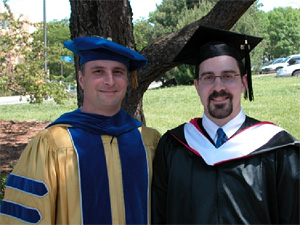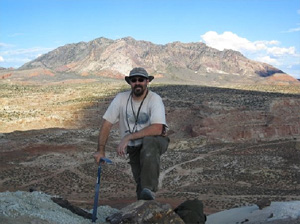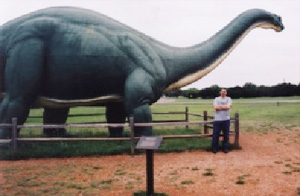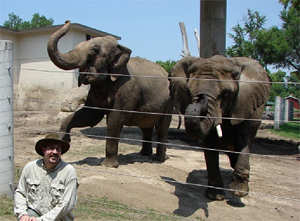 PaleoPeople
PaleoPeople
Brian Platt
University of Kansas, Lawrence, KS, USA
— Interview conducted August, 2009
Brian is a Ph.D. candidate in the Geology Department at the University of Kansas (KU). He earned his B.S. in geology with honors from Bloomsburg University of Pennsylvania in 2001. Brian completed his M.S. in geology with Erasmus Haworth Graduate Honors from KU in 2005. He was supported by a Patterson Grant from KU and his thesis on ichnology (the study of trace fossils) generated two publications on dinosaur tracks. Brian began his Ph.D. at KU in 2005 and has received support from a prestigious Madison and Lila Self Graduate Fellowship. |
 Brian (right) with his advisor Dr. Stephen Hasiotis at Brianís M.S. hooding ceremony. Photo by Dr. Robert Goldstein. |
A: I was interested in dinosaurs as a kid, and the idea of what I wanted to be when I grew up started developing on my first trip to the American Museum of Natural History. I was always checking dinosaur books out of the library to try and learn as much as I could about prehistoric life. I knew by the time I was in 5th grade that I wanted to be a paleontologist.
Q: What is your main area of interest in paleontology?
A: Ichnology, the study of trace fossils, which includes things like fossil footprints, burrows, and nests. These trace fossils are the only direct evidence we have of the behaviors of extinct organisms. Because behaviors are influenced by an organismís environment, we can use trace fossils to interpret ancient environments. I have several ongoing projects, but one that really interests me is studying elephant footprints to help me interpret fossil sauropod dinosaur footprints.
Q: Why did you choose to specialize in ichnology, particularly when you obviously love dinosaurs?
A: I wasnít quite sure which area of paleontology to specialize in. I did a report in my Sedimentology and Stratigraphy class on trace fossils unearthed at a construction site close to where I grew up. One of the rocks I found contained a perfect front and hind footprint from a crocodile more than 190 million years old. I realized that I loved working with trace fossils and using them to understand the behaviors of ancient organisms and the environments they lived in.
My love for dinosaurs lives on in the form of a growing collection of toys and other examples of dinosaurs in pop culture. I think it is very interesting to look at the evolution of dinosaur toys in relation to changing scientific ideas about dinosaurs (and this goes back to my honors project at Bloomsburg!). The overall lesson is that science is dynamic; old ideas are constantly abandoned in favor of new interpretations based on new discoveries. I am also interested in looking at how long it takes new scientific findings to make their way into pop culture; this can help scientists understand how effective we are at communicating to the public and it can also help improve science education efforts.
 Conducting field work in the Henry Mountains, Utah. Photo by Chad Motter. |
A: I went to Bloomsburg University (Pennsylvania) because I wanted a small school close to home that had a paleontologist and a good Art Department. I minored in Art and I like to try to incorporate it into my research whenever I can. To keep myself drawing, I took a course in scientific illustration at KU and I ended up having one of my homework assignments published!
When I was looking for a graduate school, I applied to programs with a strong paleo aspect, and KU has a good program. I was accepted and Steve Hasiotis took me on as a grad student.
Q: Do you plan to continue studying trace fossils after you finish your Ph.D.?
A: Yes. I will continue work using modern analogs to help me understand how and why organisms disrupt sediment and soils. And I will apply that research to help interpret ancient environments and animal behavior from fossil traces.
Q: Do you have any other projects going at the moment?
A: Iím interested in quantitative ichnology, new ways to measure and describe traces. For example, using a laser scanner to capture 3-D digital models of trace fossils that can be measured, manipulated, and animated in virtual space on a computer. I have used this to measure volume of modern and fossil tracks and burrows (which is very difficult to do accurately with other methods). These new measurements allow us to use traces in ways we never could before. For example, burrows act as pores that allow water to penetrate into soil; knowing the volume of the burrows on agricultural land will help us understand how much and how quickly water will be available for crops after it rains. The laser scanner I used is relatively small so you could take it into the field to scan in traces right off of an outcrop!
Q: What is a typical day like for you?
A: No two days are the same. Thatís what I love about paleo! I might be in my office, in the library, in the lab, or in the field! I regularly help my advisor take care of the animals in his lab that we use to study burrowing and track-making behavior; these are mostly arthropods, but there are also reptiles and amphibians,. I am currently a teaching assistant in the University of Kansas (KU) Environmental Studies Program where I assisted with a course in field ecology and a senior capstone course on environmental impact analysis and sustainability. I am helping the students with projects to make KU greener and the project results will be shared with KU administrators to consider incorporating into University policies.
 Posing with the life-size "Brontosaurus" from the 1964-65 New York Worldís Fair that now resides in Glen Rose, Texas. Photo by Emily Tremain. |
A: My trip to China in 2006. It was an NSF-funded trip, and I went as a crew member and as a trace fossil expert on the expedition. We had both Chinese and Americans on the trip, including about seven graduate students from KU. I was able to see many tourist sites in addition to conducting geological fieldwork at multiple locations. I also got to do some reconnaissance to gather data for potential future research projects.
Q: What is your favorite fossil?
A: Good question! My favorite trace fossils are some especially well preserved dinosaur tracks that I was able to work on while doing my Masterís research. There is even a skin pattern in one of the prints. A childrenís museum in Tennessee is building a life size Brachiosaurus model and they consulted Dr. Hasiotis and me about the skin pattern because they want to make it as accurate as possible.
Q: What do you plan to do once you finish your Ph.D.?
A: I want to find a position where I can do both teaching and research. I would like to have a lab like my advisorís, where I have live animals to use for burrowing and track-making experiments. I am also interested in education outreach and scientific literacy issues. I have given talks about geology and fossils to children at the Topeka Zoo and to elementary school classes. I think paleontology is a great way to get kids interested in science.
Q: What advice would you give students who might be interested in paleontology as a career?
A: Just as paleontology is a subfield within geology, there are many subfields within paleontology (one of which is ichnology). So itís a good idea to really think about what your interests are; they will help you determine what aspect of paleontology is best for you. Both geology and biology are important to study for a career in paleontology and you might become focused on one over the other depending on what subfield of paleontology you are interested in. Make sure you do your homework when you are looking into different academic programs in college so you can prepare by taking the appropriate courses.
 At the Topeka Zoo with Tembo the African elephant (right) and Sunda the Asian elephant (left). Photo by Dawn Olson. |
A: The study of fossils is important for many reasons. At a basic level, studying fossils satisfies a natural curiosity about life on Earth and how it has changed over time. Prehistoric animals like dinosaurs and large, wooly, ice age mammals fascinate us, but we wouldnít know anything about them without paleontology. Fossils tell us how extinct organisms looked, moved, behaved, lived, died, and interacted with other organisms and their environments. Fossils also yield important clues about the evolutionary histories of organisms, including our own ancient ancestors.
Prehistoric life and evolution are very interesting, but such basic research, i.e., research driven by curiosity with no immediate economic or social benefits, is sometimes difficult to justify in todayís world. Yes, paleontology provides inspiration for many income-generating creatures in the entertainment industry, but paleontologyís real relevance lies in finding solutions to the global problems we are currently facing. One of these problems is the alarming rate at which species are going extinct because of the actions of humans. Studies of the fossil record show that there have been five major mass extinctions in Earthís history where a large percentage of species on the planet died out. Species are currently disappearing so rapidly that the planet is experiencing a sixth mass extinction often referred to as the biodiversity crisis. One of the best ways to understand the potential outcomes of this crisis is to research ancient examples of environmental degradation, habitat fragmentation, and invasive species preserved in the fossil record. The lessons we learn from paleontology will help us develop effective conservation and land-use management strategies to protect and preserve biodiversity and promote sustainable lifestyles.
Perhaps the most serious problems threatening human culture, which also contribute to the biodiversity crisis, are global warming and its associated hazards. The burning of fossil fuels by humans is the primary source of the increase in greenhouse gases in the atmosphere responsible for recorded recent climate change trends. Fossils can tell us how increased global temperatures, rising sea levels, and changes in ocean circulation and weather patterns affected organisms and ecosystems in the past. We can use ancient patterns to predict what could happen in the future if current trends continue unchecked; this will help policymakers formulate legislation to mitigate the global impact of human activity.